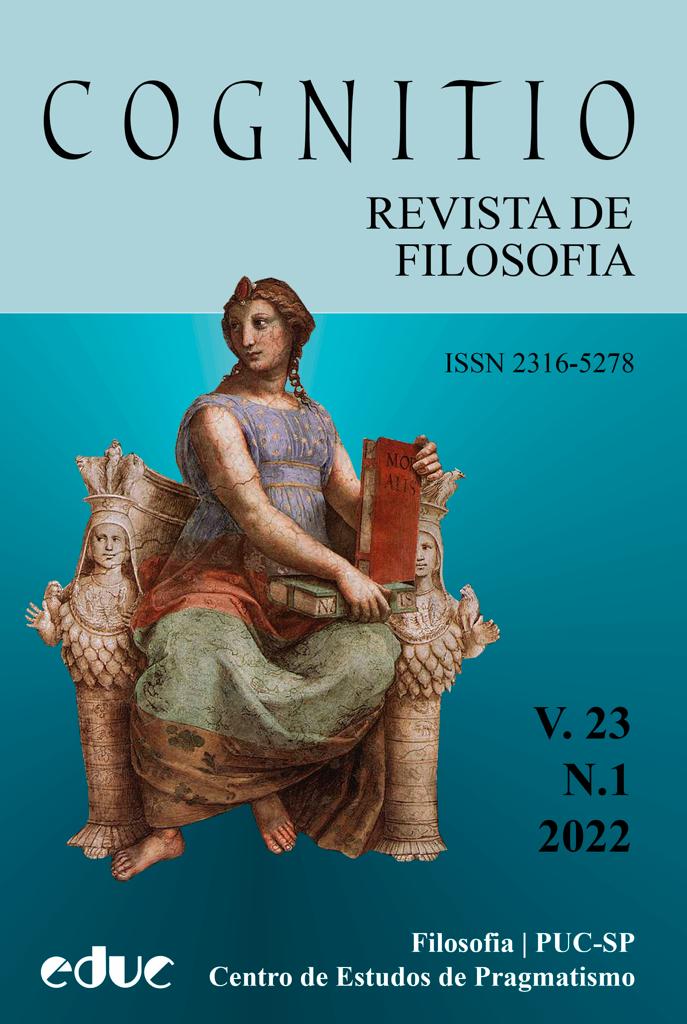Perceber emoções em (e através de) interações sociais
uma proposta deweyana
DOI:
https://doi.org/10.23925/2316-5278.2022v23i1:e59110Resumo
In our everyday interactions we can easily and effortlessly perceive emotions in others’ facial expressions and bodily behaviour. How do we do that? Philosophers and psychologists have long argued about the fundamentals of emotion perception and the debate is far from settled.While some insist on the sufficiency of morphological information contained in facial expressions, others construe the objects of emotion perception as more complex, comprising multimodal information such as touch, tone of voice, body postures, and so on. Others, in turn, have gone so far as to deny that there is a pre-given object in emotion perception in the first place, so that processes of emotion perception must be conceptualised as emergent and co-constructed phenomena in contexts of social interaction. The purpose of this paper is to argue that John Dewey’s pragmatist theory of emotions can help us make significant theoretical advancements in the understanding of emotion perception, according to which emotions are coordinated modes of behaviour that we enact with others in the contexts of social interactions. In this picture, perceiving emotions is a matter of participating in a joint activity of socio-affective coordination. This theory allows us to capture important insights that appear in these contemporary debates, while at the same time avoiding their pitfalls.
Referências
ADAMS, Reginald; KVERAGA, Kestutis. Social Vision: Functional Forecasting and the Integra- tion of Compound Social Cues. Review of Philosophy and Psychology, v. 6, n. 4, p. 591-610, 2015. DOI: https://doi.org/10.1007/s13164-015-0256-1
AVIEZER, Hillel; HASSIN, Ran. Putting Facial Expressions Back in Context. In: AM- BAD, N.; SKOWRONSKY, J. (eds.). First Impressions. New York, London: The Guilford Press, 2008. p. 255-286.
BAR, Moshe. Visual Objects in Context. Nature Reviews Neuroscience, v. 5, n. 8, p. 617-629, 2004. DOI: https://doi.org/10.1038/nrn1476
BARRETT, Lisa Feldman. The Conceptual Act Theory: A Précis. Emotion Review, v. 6, n. 4, p. 292- 297, 2014. DOI: https://doi.org/10.1177/1754073914534479
BARRETT, Lisa Feldman; MESQUITA, Batja; GENDRON, Maria. Context in Emotion Percep- tion. Current Directions in Psychological Science, v. 20, n. 5, p. 286-290, 2011. DOI: https://doi. org/10.1177/0963721411422522
BUCK, Ross. Social and Emotional Functions in Facial Expression and Communication: The Readout Hypothesis. Biological Psychology, v. 38, n. 2-3, p. 95-115, 1994. DOI: https://doi. org/10.1016/0301-0511(94)90032-9
DARWIN, C. The expression of emotion in man and animals. New York: Appleton, [1872] 2005.
DEWEY, John. The Theory of Emotion I: Emotional Attitudes. Psychological Review, v. 1, n. 6, p. 553-569, 1894. DOI: https://doi.org/10.1037/h0069054
DEWEY, John. The Theory of Emotion II: The Significance of Emotions. Psychological Review, v. 2, p. 13-32, 1895. DOI: https://doi.org/10.1037/h0070927
EKMAN, Paul. The Argument and Evidence about Universals in Facial Expressions of Emotion. In: WAGNER, H.; MANSTEAD, A. (Orgs.). Handbook of social psychophysio- logy. Hoboken, NJ: John Wiley & Sons, 1989. p. 143-164.
EKMAN, Paul; FRIESEN, Wallace. Unmasking the face: A guide to recognizing emotions from facial clues. Englewood Cliffs, NJ: Prentice Hall, 1975.
ERNST, Marc; BÜLTHOFF, Heinrich. Merging the Senses into a Robust Percept. Trends in Cogni- tive Sciences, v. 8, n. 4, p. 162-169, 2004. DOI: https://doi.org/10.1016/j.tics.2004.02.002
GENDRON, Maria; BARRETT, Lisa Feldman. Emotion Perception as Conceptual Synchrony. Emotion Review, v. 10, n. 2, p. 101-110, 2018. DOI: https://doi.org/10.1177/1754073917705717
HUFENDIEK, Rebekka. William James and John Dewey on Embodied Action-Oriented Emotions. In: JUNG, M.; MADZIA, R. (orgs.). Pragmatism and Embodied Cognitive Science: From Bodily Intersubjectivity to Symbolic Articulation. Berlin/Boston: De Gruy- ter, 2016. p. 269-288.
HURLEY, Susan. Consciousness in Action. Cambridge, MA: Harvard University Press, 1998.
JAMES, William. What is an Emotion?. Mind, v. 9, n. 34, p. 188–205, 1884. DOI: https://doi. org/10.1093/mind/os-IX.34.188
KELTNER, Dacher. et al. Emotional Expression: Advances in Basic Emotion Theory. Journal of Nonverbal Behavior, v. 43, n. 2, p. 133-160, 2019. DOI: https://doi.org/10.1007/s10919-019- 00293-3
NOË, Alva. Action in Perception. Cambridge, MA: MIT Press, 2004.
KRUEGER, Joel. Dewey’s Rejection of the Emotion / Expression Distinction. In: SOLY- MOSI, T.; SHOOK, J. R. (orgs.). Neuroscience, Neurophilosophy and Pragmatism: Un- derstanding Brains at Work in the World. New York: Palgrave Macmillan, 2014. p. 140-161.
KVERAGA, Kestutis; GHUMAN, Avniel S.; BAR, Moshe. Top-down Predictions in the Cogniti- ve Brain. Brain and Cognition, v. 65, n. 2, p. 145-168, 2007. DOI: https://doi.org/10.1016/j.ban- dc.2007.06.007
NEWEN, Albert; WELPINGHUS, Anna; JUCKEL, Georg. Emotion Recognition as Pattern Re- cognition: The Relevance of Perception. Mind and Language, v. 30, n. 2, p. 187-208, 2015. DOI: https://doi.org/10.1111/mila.12077
NOË, Alva. Action in Perception. Cambridge, MA: MIT Press, 2004.
RUSSELL, James A. Is There Universal Recognition of Emotion from Facial Expression? A Re- view of the Cross-Cultural Studies. Psychological Bulletin, v. 115, n. 1, p. 102-141, 1994. DOI: https://doi.org/10.1037/0033-2909.115.1.102
Downloads
Publicado
Como Citar
Edição
Seção
Licença
Copyright (c) 2022 http://creativecommons.org/licenses/by/4.0/

Este trabalho está licenciado sob uma licença Creative Commons Attribution 4.0 International License.









